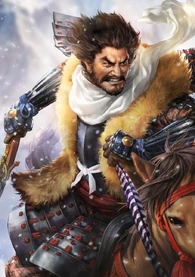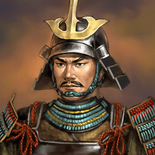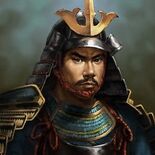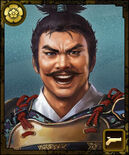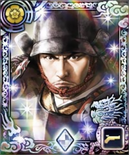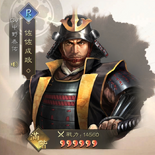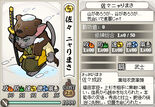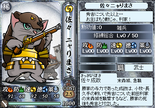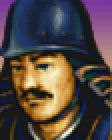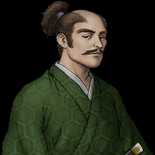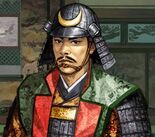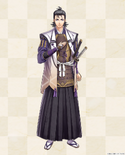| Narimasa Sassa | |
| Clan(s)/Alliance(s): | Sassa Oda Hashiba |
|---|---|
| Weapon Type: | Spear
|
| Unit Type: | Fierce |
| Significant Battle(s): | |
| First Appearance: | Samurai Warriors |
| Real name: | Sassa Narimasa
|
| Japanese name: | 佐々 成政
|
| Born: | February 6, 1536
|
| Died: | July 7, 1588
|
Narimasa Sassa (佐々 成政) is a Oda veteran retainer. Despite reportedly colluding in a plot to assassinate his lord, he stayed with the clan until Nobunaga's death. Compared to Toshiie and Katsuie, he was a fearsome warrior who often reserved his accomplishments. The exact circumstances of his death are disputed.
The Nobunaga no Yabou 201X poll for 3-star officers puts him in seventh place.
Role in Games[]
Narimasa appears in the Samurai Warriors series as an early officer of the Oda forces and fights in most battles where the Oda forces are present. He serves Ieyasu at Komaki-Nagakute.
In Pokémon Conquest, Narimasa serves as an officer of Nobunaga whose partner is a Fraxure.
Kessen III has Narimasa appear as an optional early game archer unit, joining the Oda forces in the Battle of Muraki during the second chapter. He has the unique starting combination of a ranged unit affinity combined with the warrior class.
At the start of Tokichiro's story in Taiko Risshiden V, Narimasa condemns the fresh recruit and ridicules him whenever he is present. He begrudgingly admits to the youth's progress if the player performs well in this scenario.
Voice Actors[]
- Richard Epcar - Warriors Orochi (English-uncredited)
- Kohsuke Toriumi - Hana Oboro ~Sengoku-den Ranki~
- Taisuke Nakano - Shin Nobunaga no Yabou
- Nobuyuki Hiyama - Nobunaga no Yabou Hadou
Historical Information[]
Sassa Narimasa was born to Sassa Morimasa. He entered Nobunaga's service at the age of 14 and remained in his lord's service throughout Nobunaga's rise to power. Narimasa was noted for his ability to lead matchlock forces, a position he regularly held. He was part of the rear guard in Anegawa and also participated in the battle of Nagashino, receiving personal recognition for his efforts according to the Shinchō kōki.
Narimasa would eventually work with Maeda Toshiie and Mitsuharu Fuwa in quelling rebellious Ikko-ikki in Echizen. He also began the construction of Komaru castle around this time. Their efforts in this area earned the three officers the title Sanninshu or the Echizen Triumvirate. Having quelled Echizen, Narimasa proceeded to join Shibata Katsuie in fighting the Uesugi in Etchu. He continued to provide exceptional service and received Etchu province for his efforts. Narimasa immediately set out to survey and improve his new lands, building new dams to decrease flood damage. These banks he built still bear his family name.
When Nobunaga fell to Mitsuhide, Narimasa Sassa did not immediately engage in the politics around Nobunaga's heir, but did ultimately choose to support Katsuie at Shizugatake to little avail. Although on the losing side, his support had been weak enough to escape any major punishment. However, Narimasa continued to prove contrary to Hideyoshi the following year when he supported Tokugawa Ieyasu's own fight against Hideyoshi's power. Although unable to engage in the primary conflict in Komaki-Nagakute, he did fight against Toshiie's forces in Kanazawa at Suemori Castle. Toshiie rallied, however, and drove off Narimasa, allowing Hideyoshi to bring his army north and force Narimasa's surrender.
As punishment for challenging Hideyoshi, Narimasa was forced to transfer to Higo province which had been recently taken during the Kyushu Campaign. As part of the terms, he had to surrender his wife and children as hostages in Kyoto. Already on thin ice with Hideyoshi, Narimasa soon loss control of the providence to rioters, requiring aid from Tachibana Muneshige in quelling the rebels. As punishment for his continued failure, Narimasa was ordered to commit Seppuku and died on July 7, 1588 alongside his two sons. As Narimasa was a noted skilled manager of his previous providence, it has been rumored that Hideyoshi set Narimasa up to fail, knowing the people of Higo would soon rebel regardless.
One last anecdote of Narimasa Sassa's life deserves mentioning, even though it is largely based on legend. He was supposed to have had a favorite concubine named Sayuri. She became pregnant around 1584 and caused Narimasa much joy. Nevertheless, rumors were spread by jealous concubines that the child was not his, which Narimasa ignored at first. Once he found a bag (planted by the same concubines who spread the rumors) belonging to one of his vassals in Sayuri's room. Flying into a rage, Narimasa dragged the unfortunate woman to the Jintsu riverside and bound her to a tree, where he proceeded to butcher ultimately ending his cruel act by beheading her. He also killed her entire family, numbering 18 in all. Sayuri was said to have cursed Narimasa for his offense, becoming the first fiery Furaribi, a vengeful female spirit. This curse manifested itself when he was visiting Nene after his surrender to Hideyoshi in 1587. He paid this visit thanks to her intercession on his behalf, gaining him mercy from her husband. As thanks he gave her a rare black lily, which Nene thought to be beautiful and held a tea ceremony to show it off. However, Chacha convinced her that the flower was a mockery of Nene's normally energetic personality, which provoked her to recant her protection for Narimasa and convinced Hideyoshi to demand Narimasa to commit seppuku. As Sayuri's name bears the characters for the word Lily; it was believed her curse on Narimasa was carried out through this black flower.
Etymology[]
- The name Narimasa means "become" (成) (nari) and "government" (政) (masa).
- Narimasa's surname Sassa means "help, aid" (佐).
Gallery[]
Gallery
|
|---|
100man-nin no Nobunaga no Yabou portrait Nobunaga no Yabou 201X portrait Sassa Nyarimasa in Samurai Cats
Kuranosuke in Guntama Oda Nobunaga Den portrait |

